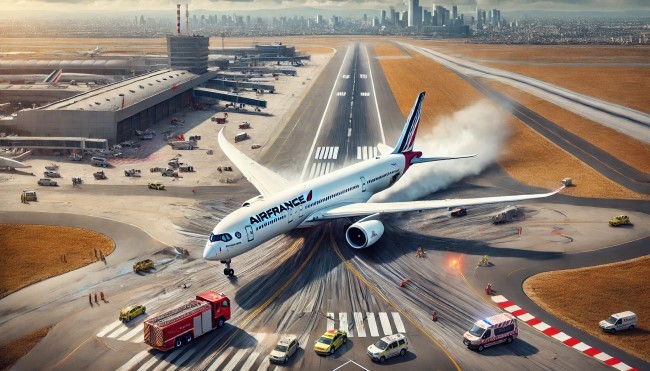Air France Plane Crash 2024: A Comprehensive Analysis of Recent Aviation Incidents and Safety Enhancements
Understanding the 2024 Air France Incidents and Their Impact on Aviation Safety

The aviation industry is one of the most scrutinized sectors when it comes to safety and operational efficiency. This scrutiny is heightened whenever an incident occurs, such as the recent events involving Air France in 2024. Despite the alarming headlines, it’s essential to dissect these incidents comprehensively to understand their causes, implications, and the steps being taken to enhance safety in the future.
Overview of Air France’s 2024 Incidents
In 2024, Air France experienced a notable incident that attracted significant media attention. While the term “crash” may evoke images of catastrophic events, the reality of the situation often involves a more nuanced understanding.
The Toronto Tailstrike Incident
On January 21, 2024, an Air France Airbus A350-900, operating as flight AF356 from Paris Charles de Gaulle to Toronto Pearson International Airport, encountered a critical incident. During its initial landing attempt, the aircraft suffered a tail strike, a situation where the tail of the plane makes contact with the runway. This type of incident can cause significant structural damage to the aircraft, although it does not necessarily endanger the passengers if managed correctly.
Incident Details
The Airbus A350-900 involved in the incident was relatively new, having been in service for only two years. As the aircraft approached Toronto, it experienced a tail strike on runway 24L. The flight crew, demonstrating commendable professionalism, initiated a go-around procedure and safely landed the aircraft on the same runway approximately 15 minutes later. The incident caused substantial damage to the fuselage, necessitating extensive repairs.
Understanding Tailstrikes and Their Implications
What is a Tailstrike?
A tail strike occurs when the tail of an aircraft contacts the runway during landing or takeoff. This can happen for several reasons, including improper landing techniques, incorrect aircraft configuration, or environmental factors such as wind shear.
Consequences of a Tailstrike
The severity of a tail strike can vary. In minor cases, the damage may be superficial, requiring only minor repairs. In more severe cases, the structural integrity of the aircraft can be compromised, necessitating extensive repairs and grounding the aircraft for an extended period.
Safety Measures and Response
Immediate Actions
Following the tailstrike incident in Toronto, Air France, and aviation authorities took immediate steps to ensure the safety of the passengers and crew. The aircraft was thoroughly inspected, and all necessary repairs were initiated to restore it to airworthiness.
Investigation and Analysis
The incident prompted a detailed investigation by aviation safety authorities, including the French Bureau d’Enquêtes et d’Analyses (BEA) and the Transportation Safety Board of Canada (TSB). These investigations aim to determine the root causes of the tail strike and to recommend measures to prevent similar incidents in the future.
Enhancing Aviation Safety: Lessons Learned
Training and Simulation
One of the key takeaways from the 2024 incidents is the importance of continuous training and simulation for pilots. Advanced simulators can replicate various scenarios, including tail strikes, allowing pilots to practice their response and improve their handling of such situations.
Technological Advancements
The aviation industry is constantly evolving, with new technologies being developed to enhance safety. Innovations such as improved avionics, real-time monitoring systems, and automated landing aids can help mitigate the risk of incidents like tail strikes.
Air France’s Commitment to Safety
Ongoing Safety Programs
Air France has a longstanding commitment to safety, with rigorous training programs and continuous investment in the latest aviation technologies. The airline’s response to the 2024 incident underscores its dedication to maintaining the highest safety standards.
Collaboration with Authorities
Air France works closely with aviation authorities worldwide to ensure compliance with safety regulations and to implement best practices. This collaboration is crucial in identifying potential risks and developing strategies to mitigate them.
The Broader Impact on the Aviation Industry
Regulatory Changes
Incidents like the Air France tailstrike often lead to changes in aviation regulations. Authorities may introduce new guidelines for aircraft maintenance, pilot training, and operational procedures to enhance safety across the industry.
Public Perception
While aviation remains one of the safest modes of transportation, public perception can be influenced by high-profile incidents. Airlines and authorities must communicate transparently about the causes of incidents and the measures being taken to prevent them.
Conclusion: Moving Forward with Confidence
The 2024 Air France incidents serve as a reminder of the complexities and challenges inherent in aviation. However, they also highlight the industry’s resilience and commitment to continuous improvement. Through rigorous training, technological advancements, and close collaboration with authorities, airlines like Air France are striving to enhance safety and maintain the trust of the traveling public.
FAQs
What happened during the Air France incident in Toronto?
The Air France Airbus A350-900 suffered a tail strike during landing, causing significant damage to the aircraft’s fuselage. The pilots managed to land the plane after a go-around safely.
What causes a tail strike?
Tailstrikes can occur due to improper landing techniques, incorrect aircraft configuration, or environmental factors such as wind shear.
How does Air France ensure passenger safety?
Air France maintains rigorous training programs for its pilots, invests in the latest aviation technologies, and collaborates closely with aviation authorities to ensure the highest safety standards.
What steps are being taken to prevent future incidents?
Continuous training, technological advancements, and regulatory changes are some of the measures being implemented to prevent similar incidents in the future.
How do incidents like these impact public perception?
While aviation incidents can influence public perception, transparent communication about the causes and preventative measures helps maintain trust in the industry.
By addressing the challenges head-on and committing to ongoing improvements, the aviation industry, including Air France, continues to prioritize passenger safety and operational excellence.



